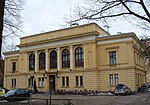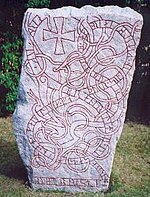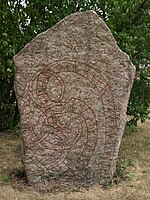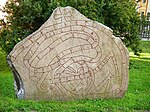Västgöta nation

Västgöta Nation, commonly known as Västgöta or VG, is one of the thirteen student nations of Uppsala University, originally intended for students from Västergötland Province. It was founded in 1639 and thus is Uppsala's oldest nation. With about 1 200 members Västgöta Nation is one of the smaller nations at Uppsala but still has extensive cultural activities including three choirs, a theatre club and an orchestra. The nation's building (Swedish: nationshus) lies along the Fyrisån and was probably built in 1604, though its cellar is much older. The building survived a citywide fire in 1702, unusually for central Uppsala. Amongst the building's former owners was Field Marshal Lennart Torstenson, and it has been in the nation's possession since 1825.
Excerpt from the Wikipedia article Västgöta nation (License: CC BY-SA 3.0, Authors, Images).Västgöta nation
Västra Ågatan, Uppsala Centrum
Geographical coordinates (GPS) Address Nearby Places Show on map
Geographical coordinates (GPS)
| Latitude | Longitude |
|---|---|
| N 59.856666666667 ° | E 17.638888888889 ° |
Address
Västra Ågatan
Västra Ågatan
753 22 Uppsala, Centrum
Sweden
Open on Google Maps











